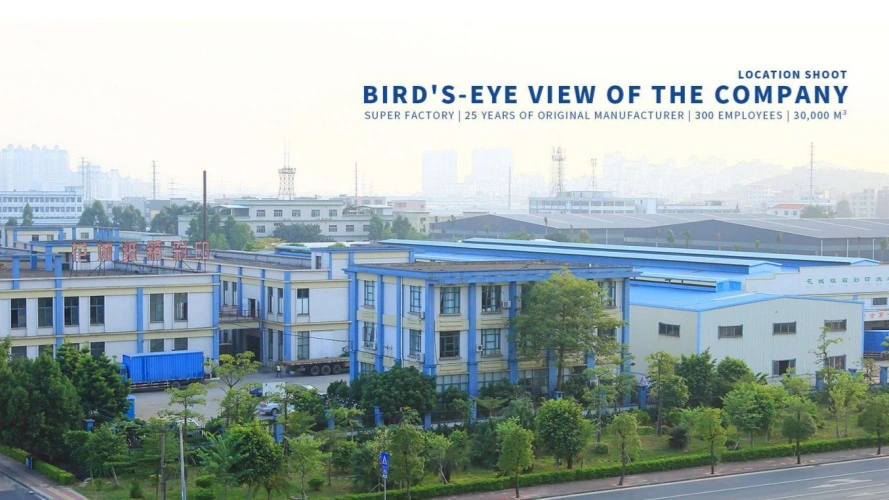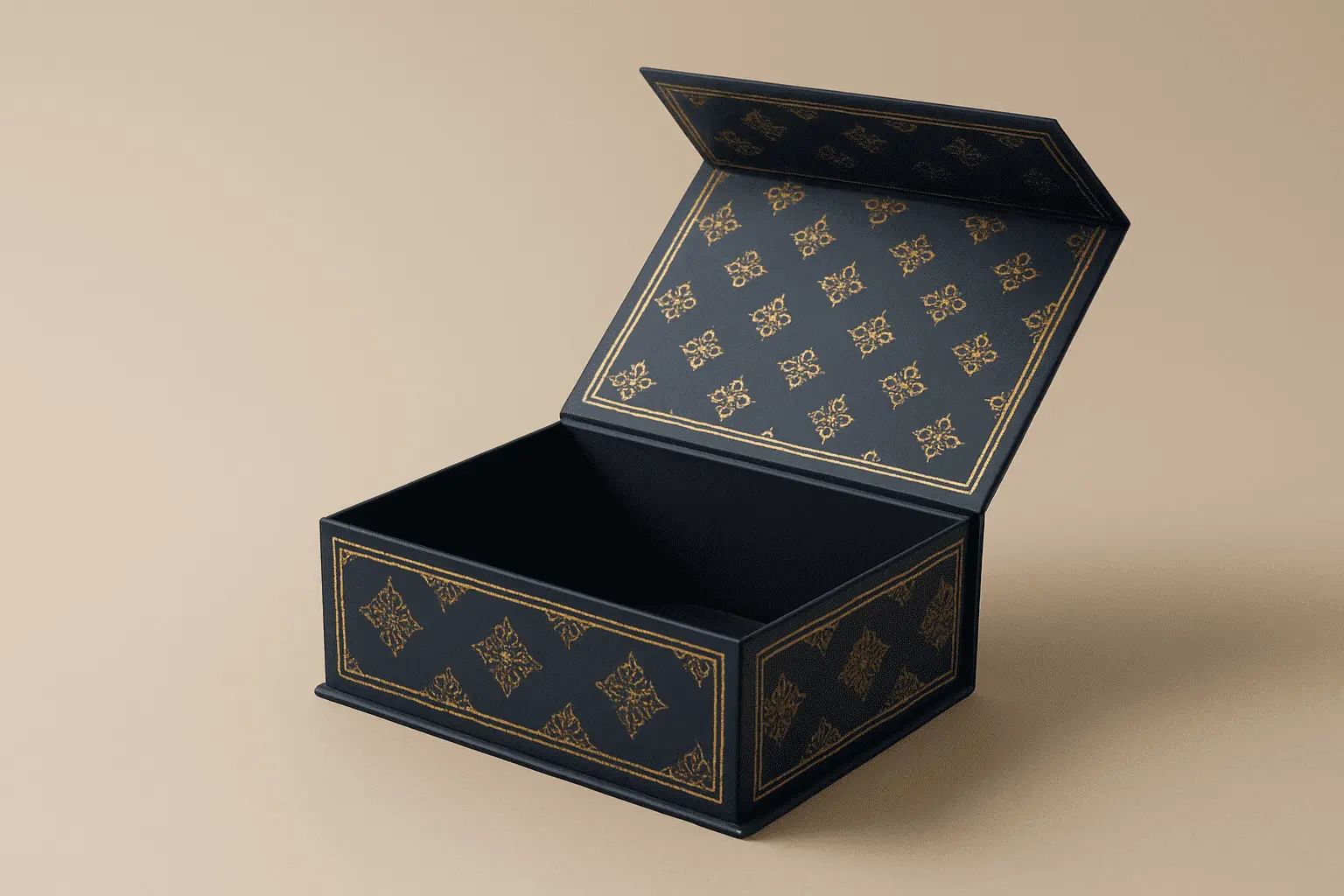Foldable Rigid Boxes: The Perfect Solution for Space-Saving Storage
Picture your warehouse filled with thousands of empty boxes taking up valuable space, or your shipping costs skyrocketing due to bulk packaging. This scenario plagues countless businesses worldwide, creating unnecessary storage burdens and inflated logistics expenses. Foldable rigid boxes emerge as the revolutionary solution that transforms this pain point into a competitive advantage. These innovative packaging solutions combine the premium appearance and durability of traditional rigid boxes with the space-saving benefits of collapsible design, offering businesses up to 60% reduction in storage and shipping costs while maintaining luxury presentation standards that enhance brand perception and customer experience.

Understanding Foldable Rigid Boxes and Their Revolutionary Design
Foldable rigid boxes represent a breakthrough in packaging engineering that addresses the fundamental challenge of space efficiency without compromising structural integrity or visual appeal. Unlike traditional rigid boxes that maintain their shape regardless of contents, foldable rigid boxes feature specially engineered creases and fold patterns that allow them to collapse flat when empty while maintaining their premium appearance when assembled. These boxes compress completely flat when empty, saving storage space in warehouses, closets, or other areas, while still providing the luxury feel of traditional rigid packaging. The construction of foldable rigid boxes involves sophisticated die-cutting techniques and precision engineering to create fold lines that maintain box integrity during repeated assembly and disassembly cycles. The materials used in these boxes include high-quality chipboard substrates combined with premium surface materials such as SBS C1S or SBS C2S paperboard, which provide the structural strength necessary for the folding mechanism while ensuring a luxurious finish suitable for premium products. The manufacturing process requires careful attention to grain direction, adhesive application, and fold line positioning to ensure consistent performance across thousands of folding cycles. Advanced manufacturing techniques incorporate automated visual positioning systems that ensure precise alignment during production, resulting in boxes that fold and unfold smoothly without compromising structural integrity. The engineering behind these boxes includes calculations for material stress distribution, fold angle optimization, and reinforcement placement to prevent wear at critical junction points. This technical sophistication enables foldable rigid boxes to withstand the rigors of commercial use while maintaining their premium appearance and functionality throughout their lifecycle.
-
Key Design Features That Enable Space-Saving Functionality
The space-saving functionality of foldable rigid boxes stems from several innovative design elements that work together to create maximum storage efficiency. The primary feature involves strategic score lines and fold patterns that allow the box walls to collapse inward without creating bulk or interfering with the folding mechanism. These score lines are precisely calculated based on material thickness, grain direction, and intended fold angles to ensure smooth operation and longevity. Corner construction represents another critical design element, with specially engineered corner tabs that maintain structural integrity during folding while allowing the box to achieve maximum compression when collapsed. The corner reinforcement system distributes stress across multiple points, preventing tearing or separation at high-stress areas. Additionally, the bottom panel design incorporates interlocking elements that provide secure closure when assembled while allowing complete flattening when collapsed. Closure mechanisms in foldable rigid boxes often feature magnetic strips embedded within the box structure, providing convenient closure without adding bulk that would interfere with the folding process. These magnetic closure systems are strategically positioned to maintain their effectiveness regardless of the box's folded or assembled state. The magnetic strength is calibrated to provide secure closure while allowing easy opening, enhancing the overall user experience without compromising the space-saving benefits.
Size Options and Applications for Maximum Storage Efficiency
The versatility of foldable rigid boxes extends across three primary size categories, each engineered to optimize storage efficiency for specific product types and applications. Large foldable rigid boxes accommodate products with heights ranging from 100-150mm, making them ideal for electronics packaging, luxury cosmetic sets, premium food products, and corporate gift presentations. These larger boxes demonstrate the most dramatic space savings, as their substantial volume when assembled contrasts sharply with their minimal footprint when collapsed. Medium foldable rigid boxes serve products with heights between 50-100mm, representing the most versatile size category for general retail applications. This size range encompasses jewelry boxes, smartphone packaging, small appliance containers, and mid-range cosmetic products. The medium size strikes an optimal balance between structural strength and collapsibility, making it the preferred choice for businesses seeking maximum flexibility in their packaging solutions. These folding containers can provide up to 80% savings in volume, demonstrating the significant impact on storage and shipping efficiency. Tiny foldable rigid boxes accommodate products with heights from 20-50mm, catering to compact luxury items such as jewelry, watches, luxury pens, and small electronic accessories. Despite their small size, these boxes maintain the same premium appearance and construction quality as their larger counterparts while offering proportional space-saving benefits. The engineering challenges in creating tiny foldable boxes require precise manufacturing tolerances and specialized folding mechanisms to ensure reliable performance despite the reduced material thickness and smaller fold radii.
-
Industry-Specific Applications and Customization Options
Different industries leverage foldable rigid boxes to address unique packaging challenges while maximizing storage efficiency. The cosmetics industry particularly benefits from these solutions, as beauty products require premium presentation to justify their price points while companies face significant inventory storage costs. Foldable rigid boxes allow cosmetics manufacturers to maintain luxury packaging standards while reducing warehouse space requirements by up to 60% compared to traditional rigid boxes. The electronics industry utilizes foldable rigid boxes for products ranging from smartphones to accessories, where protective packaging is essential but storage efficiency directly impacts profitability. The ability to ship flat-packed boxes to assembly facilities and retail locations significantly reduces transportation costs while ensuring products receive appropriate protection during transit and display. Consumer electronics companies report substantial cost savings in both storage and logistics when transitioning to foldable rigid box solutions. Food and beverage companies increasingly adopt foldable rigid boxes for premium products, seasonal packaging, and gift sets. The food-safe materials available for these boxes, including FDA-approved substrates and inks, ensure product safety while providing the premium presentation expected by consumers. The ability to store large quantities of collapsed boxes allows food companies to respond quickly to seasonal demand fluctuations without maintaining excessive inventory of assembled packaging.
Manufacturing Process and Quality Assurance Standards
The manufacturing process for foldable rigid boxes requires precision at every stage to ensure consistent quality and reliable performance. The process begins with material selection, where substrates undergo rigorous testing for strength, fold endurance, and surface quality. Premium materials such as SBS C1S provide the optimal combination of structural integrity and printability, while duplex chipboard offers cost-effective solutions for applications where pure white surfaces are not required. Printing represents a critical manufacturing stage where offset, digital, or flexographic processes transfer designs onto the substrate with precise color matching and registration. Advanced color management systems, including G7 color standards, ensure consistent reproduction across production runs while maintaining the vibrant colors and sharp details essential for premium packaging. The printing process accommodates various surface treatments, including spot UV coating, foil stamping, and embossing, which enhance visual impact while maintaining compatibility with the folding mechanism. Die-cutting operations create the precise shapes and fold lines essential for proper box function, utilizing custom-made steel rule dies manufactured to exacting tolerances. Computer-controlled die-cutting equipment ensures consistent cut quality and dimensional accuracy across large production runs. The creasing operations that create fold lines require careful pressure calibration to achieve clean folds without compromising material integrity or creating premature wear points. Surface finishing processes enhance both appearance and durability while ensuring compatibility with the folding mechanism. UV coating applications provide scratch resistance and enhanced gloss while maintaining flexibility at fold lines. Lamination processes add protective films that enhance durability without adding excessive bulk that would interfere with the collapsing function. Quality control throughout the manufacturing process includes fold testing, dimensional verification, and visual inspection to ensure every box meets performance specifications.
-
Advanced Production Technologies and Automation
Modern foldable rigid box production incorporates automated visual positioning systems that ensure precise alignment during manufacturing operations. These systems utilize computer vision technology to monitor box position and orientation throughout the production process, automatically adjusting equipment settings to maintain optimal quality. The automation reduces human error while increasing production speed and consistency, enabling cost-effective production of complex folding structures. Automated gluing systems apply adhesives with precision control over placement, quantity, and timing to ensure optimal bond strength without creating excess bulk at fold lines. These systems accommodate different adhesive types, including hot melt, cold glue, and pressure-sensitive adhesives, depending on specific application requirements. The precision application prevents adhesive migration that could interfere with folding mechanisms while ensuring reliable box assembly and structural integrity. Quality assurance systems integrated throughout the production line continuously monitor critical parameters such as fold line position, adhesive placement, print registration, and dimensional accuracy. Statistical process control systems track production data in real-time, enabling immediate adjustments when parameters drift from specifications. This continuous monitoring ensures consistent quality while minimizing waste and reducing production costs through early detection of potential issues.
Cost Benefits and Environmental Impact Analysis
The economic advantages of foldable rigid boxes extend far beyond simple storage space savings, creating comprehensive cost reductions throughout the supply chain. Primary savings occur in warehouse storage, where the ability to store boxes in collapsed form reduces space requirements by 60-80%, directly translating to reduced warehousing costs or increased inventory capacity within existing facilities. Collapsible rigid boxes ship flat, allowing businesses to reduce packaging bulk, lower shipping expenses, and optimize storage efficiency. Transportation cost reductions represent another significant benefit, as collapsed boxes require substantially less shipping volume than traditional rigid boxes. This reduction allows companies to ship larger quantities of boxes in each shipment, reducing per-unit transportation costs and enabling more efficient logistics operations. The weight reduction associated with optimized packaging also contributes to shipping cost savings, particularly for companies utilizing weight-based shipping rates. Labor cost efficiencies result from simplified inventory management, as collapsed boxes require less handling time for storage and retrieval operations. Workers can move larger quantities of boxes in each operation, reducing the labor hours required for warehouse operations. Assembly time for foldable rigid boxes is typically comparable to traditional boxes once workers become familiar with the process, ensuring that operational efficiency is maintained while achieving storage and shipping benefits. Environmental benefits complement the economic advantages, as foldable rigid boxes support sustainability initiatives through reduced transportation emissions and optimized material usage. The reduced shipping volume directly translates to lower carbon emissions per box unit, supporting corporate environmental goals while reducing costs. Material efficiency improvements result from optimized design that eliminates unnecessary bulk while maintaining structural performance, contributing to reduced environmental impact throughout the product lifecycle.
-
Long-term Economic Impact and Return on Investment
Companies implementing foldable rigid boxes typically achieve full return on investment within the first year of implementation, with ongoing savings accumulating significantly over time. The initial investment in new packaging design and setup costs is rapidly offset by the combination of storage, shipping, and operational cost reductions. Long-term savings continue to accumulate as companies benefit from reduced warehouse expansion needs and improved logistics efficiency. Competitive advantages emerge as companies utilizing foldable rigid boxes can offer more competitive pricing while maintaining premium packaging quality. The cost savings achieved through space-efficient packaging can be reinvested in product development, marketing initiatives, or passed along to customers as price advantages. This flexibility enhances market position and supports business growth objectives while maintaining packaging quality standards. Market differentiation opportunities arise as foldable rigid boxes demonstrate corporate innovation and environmental responsibility to customers and business partners. The combination of premium presentation and sustainable design appeals to environmentally conscious consumers while showcasing technological advancement and operational efficiency to business customers. This differentiation can support premium pricing strategies and enhanced brand positioning in competitive markets.
Material Selection and Premium Finishing Options
Material selection for foldable rigid boxes requires careful consideration of multiple factors including structural requirements, aesthetic goals, and cost constraints. SBS C1S paperboard represents the premium choice for applications requiring superior print quality and structural integrity, providing a bright white coated surface ideal for high-end graphics while maintaining the strength necessary for reliable folding performance. The uncoated reverse side ensures optimal adhesive bonding during assembly while providing sufficient grip for handling. SBS C2S paperboard offers dual-side coating for applications requiring premium appearance on both interior and exterior surfaces, making it ideal for boxes that will be displayed with the interior visible. The food-safe properties of SBS materials make them suitable for direct food contact applications, expanding the range of products that can utilize foldable rigid box solutions. The superior brightness and whiteness of SBS materials enhance color reproduction and overall package appeal. CCNB provides a cost-effective alternative for applications where premium appearance is required on the exterior surface only, utilizing recycled content to support sustainability goals while reducing material costs. The grey recycled back provides adequate strength for folding applications while the coated front surface accepts high-quality printing and finishing processes. Brown kraft materials offer natural aesthetic appeal for organic and artisanal products while providing excellent strength characteristics and environmental credentials. Metallic substrates create distinctive luxury packaging that stands out in retail environments while maintaining the folding functionality essential for space-saving storage. These materials accept specialized printing and finishing processes that create unique visual effects, supporting premium brand positioning and enhanced shelf appeal. The reflective properties of metallic substrates enhance lighting effects and create dynamic visual presentations that attract consumer attention.
-
Advanced Finishing Techniques for Enhanced Appeal
UV coating applications provide multiple benefits including enhanced gloss, improved scratch resistance, and protective properties that maintain package appearance throughout the distribution cycle. Spot UV applications create tactile contrast and visual interest by selectively applying high-gloss coating to specific design elements, enhancing logo prominence and creating sophisticated visual effects. The curing process creates a durable finish that withstands handling while maintaining flexibility at fold lines. Hot foil stamping transfers metallic or colored foil to specific areas of the package, creating premium accents that enhance brand presentation and perceived value. The heat and pressure process creates permanent bonding between foil and substrate, ensuring durability throughout the package lifecycle. Multiple foil colors and finishes enable sophisticated design effects that support premium brand positioning and enhanced consumer appeal. Embossing and debossing processes create three-dimensional relief effects that add tactile interest and visual depth to package designs. The combination of raised and recessed elements creates sophisticated textures that enhance the premium feel associated with rigid packaging. These processes can be combined with other finishing techniques to create layered effects that maximize visual impact and brand differentiation.
Conclusion
Foldable rigid boxes represent the ideal convergence of premium packaging aesthetics and practical space-saving functionality, delivering up to 60% storage cost reductions while maintaining the luxury presentation essential for brand differentiation in competitive markets.
Cooperate with GUANGZHOU FETCHING COLOR PRINTING & PACKAGING LTD.
As a leading China Foldable Rigid Boxes manufacturer and China Foldable Rigid Boxes supplier with over 25 years of industry experience, Guangzhou Fetching Color Printing & Packaging Ltd. operates from a state-of-the-art 50,000㎡ manufacturing facility staffed by 300+ skilled employees. Our advanced equipment including KBA106-(9+1) UV printing machines and Heidelberg XL162-6L systems ensures superior quality Foldable Rigid Boxes for sale at competitive Foldable Rigid Boxes prices. Our R&D team of 10+ packaging engineers provides comprehensive solutions from design to delivery, supported by ISO9001-2015, FSC, and Disney certifications. Whether you're seeking China Foldable Rigid Boxes wholesale solutions or High Quality Foldable Rigid Boxes for premium applications, contact us at public@fetchingprinting.com for expert consultation and competitive pricing.
FAQ
Q: What are the main size options available for foldable rigid boxes?
A: We offer three sizes - Large (100-150mm height), Medium (50-100mm height), and Tiny (20-50mm height), each with patented proprietary structures for optimal space-saving performance.
Q: How much space can foldable rigid boxes save compared to traditional rigid boxes?
A: Foldable rigid boxes can save more than 60% of shipping and storage costs compared to traditional rigid boxes, and 20-30% compared to standard collapsible boxes.
Q: What materials can be used for manufacturing foldable rigid boxes?
A: We utilize premium materials including SBS C1S, SBS C2S, CCNB, Brown Kraft, metallic papers, and rigid substrates like grey chipboard and duplex chipboard for different applications.
Q: What finishing options are available for foldable rigid boxes?
A: Our boxes support hot foil stamping, UV coating, embossing, debossing, spot UV, holographic foil stamping, and various lamination options to enhance visual appeal and functionality.
References
1. "Sustainable Packaging Solutions in Modern Manufacturing" - International Packaging Institute - Journal of Advanced Packaging Technology, Vol. 45, 2024
2. "Cost-Benefit Analysis of Collapsible Rigid Packaging Systems" - Dr. Sarah Chen, MIT Supply Chain Management - Packaging Economics Review, Issue 3, 2024
3. "Material Science Applications in Foldable Box Engineering" - Prof. Michael Rodriguez, Stanford University - Advanced Materials in Packaging, 2024 Edition
4. "Environmental Impact Assessment of Space-Saving Packaging Solutions" - Global Sustainability Packaging Council - Environmental Packaging Standards Report, 2024

Based on your location and order quantity, you will have the opportunity to receive a limited time free shipping promotion!

Corporate Purpose
